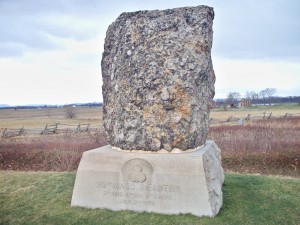Tag: memorial
John Buford Memorial
January 5, 2016 The three thousand cavalry troopers led by John Buford on the first day of Gettysburg were tasked with slowing down the Confederate advance long enough for Union reinforcements to arrive on the field. The combination of skill and luck used by General Buford successfully blunted the advance of Heth’s division on McPherson’s Ridge and contributed greatly to eventual Union victory at Gettysburg.
The three thousand cavalry troopers led by John Buford on the first day of Gettysburg were tasked with slowing down the Confederate advance long enough for Union reinforcements to arrive on the field. The combination of skill and luck used by General Buford successfully blunted the advance of Heth’s division on McPherson’s Ridge and contributed greatly to eventual Union victory at Gettysburg.
Born in Kentucky, General Buford’s promising military career was cut short when he came down with typhoid fever in the autumn of 1863. This illness resulted in his passing in December of the same year.
The Buford Memorial Association was formed in 1888 with the mission of erecting a suitable memorial on the field.
Located on the Chambersburg Pike, the John Buford Memorial was dedicated on July 1, 1895.
Surrounding the base are four Ordnance Rifles, the kind which were used in a Horse Artillery Battery. Among these guns is to be found number 233 and according to John Calef who commanded such a battery under Buford’s command, this was the gun that fired the very first Union artillery shot of the battle.
The “Harvard Regiment”
February 2, 2012“Scarcely any Union regiment was in the heart of the storm longer than the Twentieth Massachusetts,” says History Today magazine. They weathered through nearly every battle of the Army of the Potomac, and a few others to boot. At Gettysburg, the men defended a pivotal position during Pickett’s Charge—an assault that, if successful, could have turned the tide of the Civil War. For all that they accomplished, the War took its toll on them: they suffered the highest casualties of any Massachusetts regiment and the fifth highest in the Union.
Known as “The Harvard Regiment,” the 20th Massachusetts Volunteer Infantry was formed in Roxbury, MA. All of the officers, and a portion of the enlisted men, were Harvard graduates, hence the nickname. The regiment was catapulted into battle in October, 1861, a mere month out of basic training; it was four years before they laid down their weapons at the end of the war. Among the Harvard men who served was Oliver Wendell Holmes Jr., who would go on to be nominated to the Supreme Court by Teddy Roosevelt and be remembered as one of the most influential Justices in American history.
One “celebrity” of the Harvard Regiment was Colonel Paul J Revere, who was killed in the Battle of Gettysburg. He was the grandson of his namesake, the midnight rider and patriot of the American Revolution. An unusual monument—a puddingstone boulder—was erected in memory of Revere and the 43 other men of his company who died at the Battle of Gettysburg. The 30-ton colossus, dedicated in 1886, was imported by train from Roxbury, where many of the soldiers grew up. Now, it can be visited on Hancock Avenue, near the immortalized “copse of trees” and the Confederate High Water Mark.
For more monuments that “rock,” click here and here!
